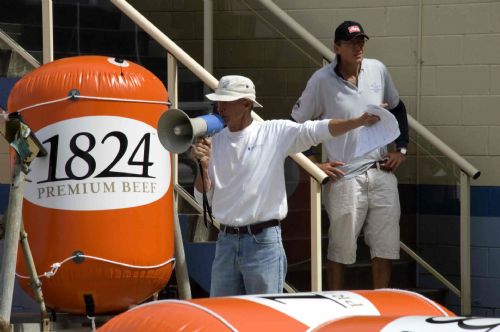Peter Moor's Tip & Tricks

Class Web Logo 08
Tips for young players!
For what it is worth, some observations from many years of involvement with F11’s that coaches, clubs and competitors might benefit from noting:
1. In fresh conditions, downwind especially, many in the back half of the fleet are sitting too far forward. This is not only slow but dangerous downwind as the F11 has very little rocker which combined with the wide flat buoyant aft sections means the bow digs in easily, making steering very difficult.
The bear away at the top mark in fresh conditions can be made far faster, easier and safer if the crew sit well aft as the boat bears away.
2. When bearing away at the top mark many try to set kites while close reaching, this is fine in light airs but dangerous, difficult and slow in fresh conditions. It is much easier and safer to bear away hard, almost to a run, set the kite and then think about coming up to the course to the gybe mark.
Similarly at the gybe, run, then gybe, then run, before attempting to come up to the new course. Many boats at the back half of the fleet can gybe OK on the running leg but come to grief at the gybe mark. So the message should be, “when you get to a gybe mark in strong winds think of it as a gybe while running square”. If the gybe takes a few minutes longer, not much time is lost as the bottom reach will be faster and if too tight towards the bottom mark, 2 sail reach the last bit.
All much quicker than capsizing in a wild gybe the moment the boat gets to the gybe mark.
3. Similarly we note time and time again that most boats sail very high on the first reach, often fighting the gusts instead of running away with them. Then as they approach the gybe mark they end up running almost square. Some in the back half of the fleet probably sail 15% longer course as each boat sail slightly higher than the one in front.
The shortest distance between 2 marks is a straight line, and usually it is faster on a reach to sail slightly low especially in the gusts in fresh conditions, only coming up high of the straight line close to the gybe mark in preparation for the gybe.
A far better game plan is to run away hard while setting the kite then sail low for a while to ensure good separation from windward boats, easy to do as most will sail very high. On approaching the gybe mark the low boats will have nearly twice the speed.
At most venues the first reach is close to land, so a low course is more likely to be in more wind. Avoid the wind shadow, “low is the go”!
4. Upwind in fresh conditions very few boats appear to pull down on the cunningham or pull out on the foot to flatten the sail, or pull up the centreboard slightly. These adjustments not only make the boat easier to sail but faster.
Actually all really Sailing 101 and well documented by the likes of Manfred Curry back in the 1930’s!
Hope this helps!
Peter Moor
